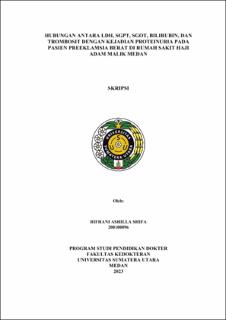| dc.description.abstract | Background: Preeclampsia is a cause of morbidity and mortality in pregnant
women, ranking third as a cause of maternal death in Indonesia. Preeclampsia is a
syndrome that occurs during pregnancy, characterized by elevated blood pressure
and the presence of protein in the urine. The disease is marked by worsening
conditions, including hemolysis, elevated liver function, and thrombocytopenia.
Early detection of preeclampsia is closely related to proteinuria. Objective: To
identify the relationship between LDH, bilirubin, SGPT, SGOT, and platelets with
proteinuria in severe preeclampsia patients. Method: This research uses a
quantitative approach with a retrospective analytical design and a cross-sectional
method with chi-square and Fisher’s exact tests. The data used in this study are
secondary data taken from the medical records of patients diagnosed with Severe
Preeclampsia at Haji Adam Malik Central General Hospital in Medan from
January 2020 to March 2023. Results: The highest incidence was found in pregnant
women aged 20-35 years. It was found that 74.3% of the population had semiquantitative
urine protein levels ≥+2. The average levels of LDH, total bilirubin,
SGPT, SGOT, and platelets were 514.64 U/L, 0.9 mg/dL, 57.77 U/L, 64.01 U/L, and
197,585/mm3, respectively. Statistical analysis showed a significant relationship
between proteinuria and LDH (p 0.001). However, there was no significant
relationship between liver function and platelets with proteinuria. Conclusion:
There is a relationship between LDH and proteinuria in severe preeclampsia
patients. | en_US |


